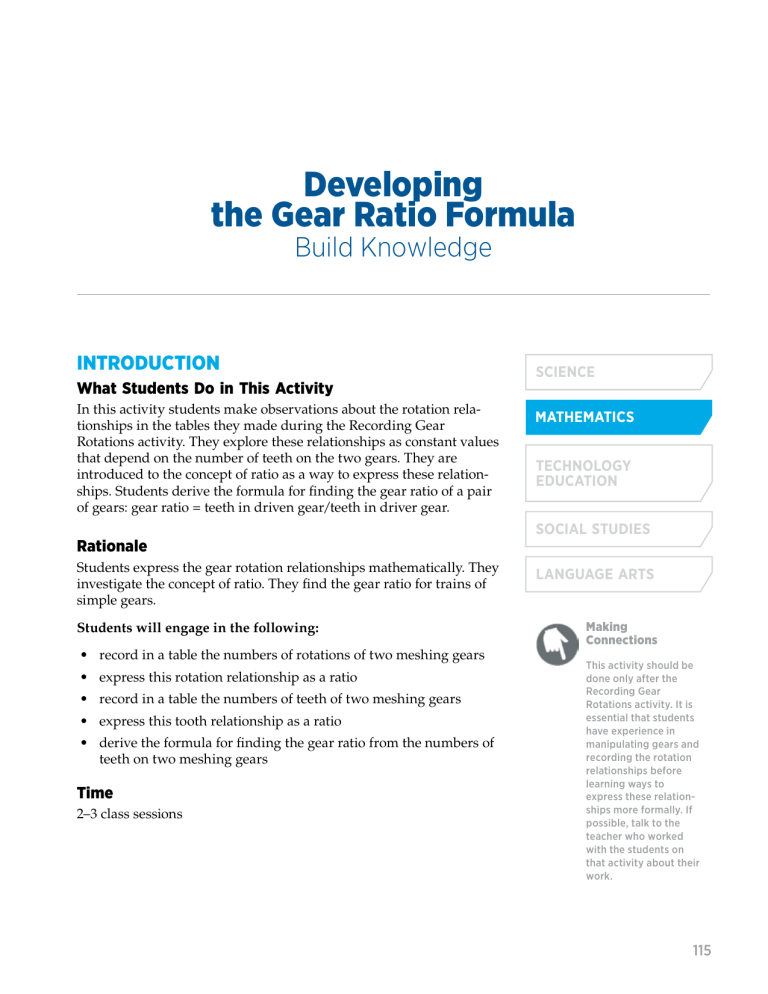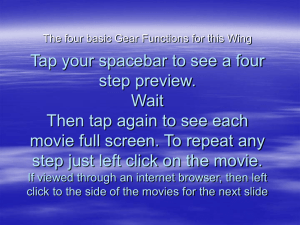
Developing the Gear Ratio Formula Build Knowledge INTRODUCTION What Students Do in This Activity In this activity students make observations about the rotation relationships in the tables they made during the Recording Gear Rotations activity. They explore these relationships as constant values that depend on the number of teeth on the two gears. They are introduced to the concept of ratio as a way to express these relationships. Students derive the formula for finding the gear ratio of a pair of gears: gear ratio = teeth in driven gear/teeth in driver gear. Rationale Students express the gear rotation relationships mathematically. They investigate the concept of ratio. They find the gear ratio for trains of simple gears. Students will engage in the following: • record in a table the numbers of rotations of two meshing gears • express this rotation relationship as a ratio • record in a table the numbers of teeth of two meshing gears • express this tooth relationship as a ratio • derive the formula for finding the gear ratio from the numbers of teeth on two meshing gears Time 2–3 class sessions SCIENCE MATHEMATICS TECHNOLOGY EDUCATION SOCIAL STUDIES LANGUAGE ARTS Making Connections This activity should be done only after the Recording Gear Rotations activity. It is essential that students have experience in manipulating gears and recording the rotation relationships before learning ways to express these relationships more formally. If possible, talk to the teacher who worked with the students on that activity about their work. 115 Developing the Gear Ratio Formula Materials • for each student, one copy of the Gear Ratio Recording Table • the Gear Rotation Recording Tables students made in the Recording Gear Rotations activity CLASSROOM ACTIVITY Activity Description In the Recording Gear Rotations activity students observed and recorded the rotation relationships of each gear in a meshing pair. Ask students to get out the tables they recorded in that activity. Drawing of Gear Pair (driver, driven) 15 45 Teeth on Teeth on Rotations of Rotations of Driver Gear Driven Gear Driver Gear Driven Gear 15 45 3 1 Ask students to consider the 15/45 gear train. Ask: If I rotate the 15-tooth driver gear 3 times how many times would the 45-tooth driven gear rotate? Most students will probably now understand that if the 15-tooth gear rotates 3 times the 45-tooth gear will rotate 1 time. Now ask students to give the numbers of rotations for the 45-tooth driven gear for several different numbers of rotations of the 15-tooth driver gear. How many times would the 45-tooth driven gear rotate if I rotate the 15-tooth driver gear 6 times? 9 times? How do you know? Ask students to explain how they can find the numbers for the rotation of the 45-tooth gear given the number of rotations of the 15-tooth gear. Help them focus on the relationship between the rotating gears as they explain their answers. The relationship of the two meshing gears does not change. Their teeth keep them rotating together in the same relative numbers of rotations. The 15-tooth gear always rotates 3 times for every 1 rotation of the 45-tooth gear. Another way of saying this is that the 15-tooth gear rotates 3 times as fast as the 45-tooth gear. This relationship will always be true no matter how many times the 15-tooth gear rotates. The relationship of rotations of the two gears is constant. It does not depend on how many times the gears rotate, or on how fast they rotate. We use the word ratio to describe this constant relationship between two values. A gear ratio is the ratio of the number of rotations of a driver gear to the number of rotations of a driven gear. 116 Build Knowledge A colon is often used to show a gear ratio: gear ratio = rotations of a driver gear : rotations of a driven gear. SCIENCE For every rotation of the 45-tooth gear, the 15-tooth gear must rotate 3 times. This is true no matter how many times the 45-tooth gear rotates. The ratio between the rotations of the 15-tooth driver gear and the 45-tooth driven gear is 3 to 1. That is, the gear ratio is 3 to 1. Using the colon notation, the gear ratio is 3:1. The order of the two numbers in a ratio is very important. In this case, the ratio of the 15-tooth driver gear and the 45-tooth driven gear is 3:1. A gear ratio is always given as the ratio of the rotations of the driver gear to the rotations of the driven gear. In terms of the bicycle example the students used earlier, the gear ratio is the ratio of pedal rotations to wheel rotations. MATHEMATICS TECHNOLOGY EDUCATION SOCIAL STUDIES LANGUAGE ARTS Use another gear pair on the students’ table as an example for further examination: If the 75-tooth driver gear rotates 3 times, how many times will a 15-tooth driven gear rotate? What if the 75-tooth driver gear rotates 5 times? How do you know? Again, help the students focus on the relationship between the gears. In this case, the 15-tooth gear rotates 5 times for every rotation of the 75-tooth gear. This is true regardless of the number of times the 75-tooth gear rotates. What is the gear ratio of a 75-tooth driver gear and a 15-tooth driven gear? The gear ratio is 1:5. Ask students to complete the Teeth Ratio and Gear Ratio columns in the table. Drawing of Gear Pair (driver, driven) Teeth on Driver Gear Teeth on Driven Gear Gear Ratio Teeth (driver Ratio Rotations Rotations rotations: (driver: of Driver of Driven driven driven) Gear Gear rotations) Teacher Tip 15 45 15 45 15:45 (or 1:3) 3 1 3:1 Facilitating Student Exploration It is critical that students see the difference between the ratio of teeth and the gear ratio. A gear ratio is the ratio of rotation. A gear with fewer teeth must rotate more times when it meshes with a gear that has more teeth. If students are unsure of the difference, you can show them examples using the gears in the materials. For example, the 15-tooth gear has to rotate 5 times to turn the 75-tooth gear 1 time. You may want to tell students that there are conventions in which numbers to use when expressing gear ratios in order to avoid numbers less than 1. If the driver gear rotates faster than the driven gear, the gear ratio is often given in the form (driver gear rotations):1. If the driven gear rotates faster than the driver gear, the gear ratio is often given in the form 1:(driven gear rotations). 117 Developing the Gear Ratio Formula Sharing and Interpreting When students have completed the two ratio columns, they can discuss their findings. Is there a relationship between the gear ratio and the tooth ratio? What is that relationship? Allow students time to express their ideas. Ask them to provide reasons for their statements. Help students see how the tooth ratio can be used to find the gear ratio. This relationship between the tooth ratio and the gear ratio is very important. It allows us to find a gear ratio without actually having to build a gear train and turn the gears. We can find the ratio of any two gears if we know the number of teeth on each of the gears. Show students how the gear ratio can be expressed as a fraction. Write this equation on the board: gear ratio = rotations of driver gear rotations of driven gear This format uses a fraction to express a gear ratio. 15 45 A B For this gear pair, the gear ratio = rotations of gear A rotations of gear B = 3 1 This is another way of saying that gear A rotates 3 times while gear B rotates 1 time. It’s the same as saying the gear ratio is 3:1. If we know the number of times gear A rotates we can divide that number by 3 to find the number of times gear B rotates. You can now ask the class: What’s a way to find a gear ratio without actually turning the gears? Students may answer that you can use the numbers of teeth on the gears to find the gear ratio. Add the teeth ratio expression to the equation you wrote earlier: gear ratio = 118 rotations of driver gear rotations of driven gear = teeth of driven gear teeth of driver gear Build Knowledge Help students understand that the rotation expression and the teeth expressions are equivalent. You can use the numbers from the above example in order to make this clearer: gear ratio = 3 1 = 45 15 Help students see that they can find the gear ratio using only the numbers of teeth on the gears. Write the following equation on the board: gear ratio = teeth of driven gear teeth of driver gear SCIENCE MATHEMATICS TECHNOLOGY EDUCATION SOCIAL STUDIES LANGUAGE ARTS Tell students that they will be able to use this formula to find the gear ratio for any two gears if they know the number of teeth on both gears. They can simply divide the number of teeth on the driven gear by the number of teeth on the driver gear to find the gear ratio. In the Using the Gear Ratio Formula activity students will use this formula to find gear ratios. 119 Developing the Gear Ratio Formula NOTES 120 Student Reproducible Master GEAR RATIO RECORDING TABLE Name__________________ Design Team________________Date__________ Drawing of Gear Pair (driver, driven) Teeth on Teeth on Driver Gear Driven Gear 15 45 45 15 15 75 75 15 45 75 75 45 Teeth Ratio (driver: driven) Gear Ratio (driver rotations: Rotations of Rotations of driven Driver Gear Driven Gear rotations) 121 Student Reproducible Master GEAR RATIO RECORDING TABLE Name__________________ Design Team________________Date__________ Drawing of Gear Pair (driver, driven) Teeth on Teeth on Driver Gear Driven Gear Teeth Ratio (driver: driven) Gear Ratio (driver rotations: Rotations of Rotations of driven Driver Gear Driven Gear rotations) 123


